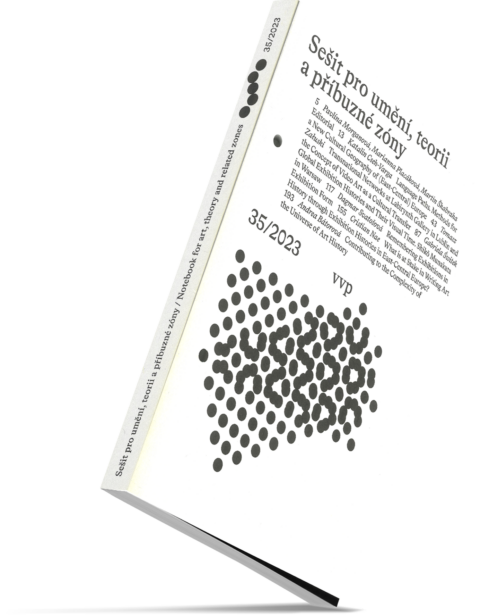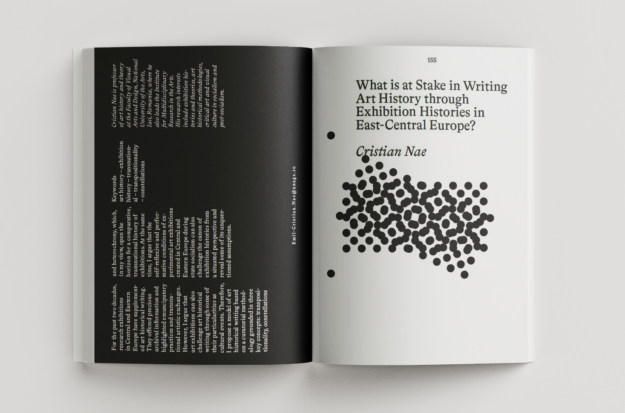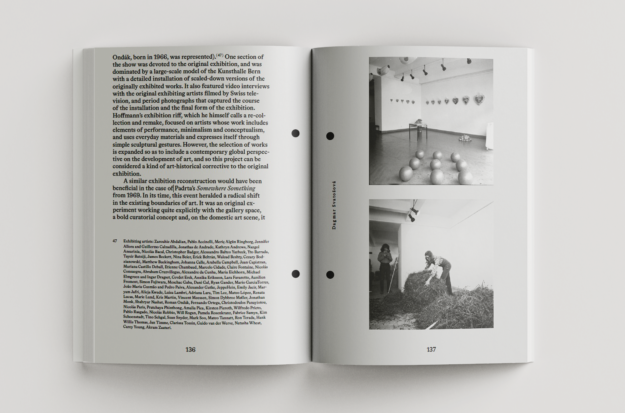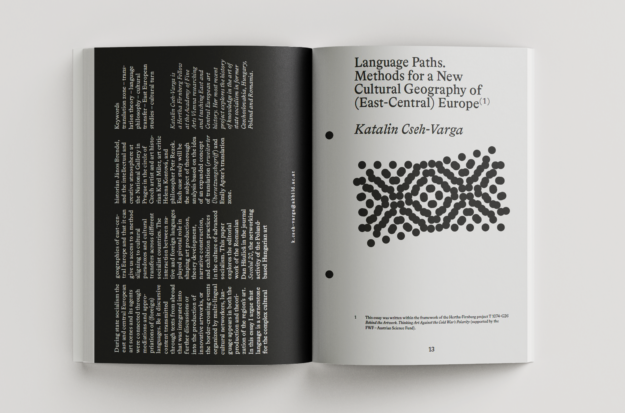The 35th issue of Notebook for Art, Theory and Related Zones returns to the topic of exhibition history. Given its international line-up, the issue is entirely in English. The texts are all based on papers presented at the series of conferences entitled Resonances, which was the outcome of a collaboration involving the AVU Research Institute, the Central European Research Institute for Art History in Hungary (KEMKI), the Art History Department at Jan Amos Comenius University in Bratislava, and the Piotr Piotrowski Centre for Research on East-Central European Art at the Adam Mickiewicz University in Poznań. In the first paper, entitled “Language Paths: Methods for a New Cultural Geography of (East-Central) Europe”, Katalin Cseh-Varga explores the key role of language within the cultural geography and transfers of the countries of our region during the era of state socialism. The concept of cultural transfer also features in the article by Tomasz Załuski entitled “Transnational Networks at Galeria Labirynt in Lublin and the Concept of Video Art as a Cultural Transfer”. Załuski shows how the complexity of artistic networks transcends the limits of methodological nationalism, the dichotomy of “official” and “unofficial” art, and the notion of a one-way transfer from West to East. In her article entitled “Global Exhibition Histories and Their Visual Time: Shikō Munakata in Warsaw”, Gabriela Świtek analyses the differences between the Western and Eastern cultural environments, using the example of the different reception and locally specific “visual time” of the exhibition of work by the Japanese artist Munakata in 1961. Dagmar Svatošová also takes us back to the 1960s in her study “Remembering Exhibitions in Exhibition Form: Czech Exhibitions as Active Co-Creators of the Art History Narrative at the End of the 1960s”, in which she explores the legacy of the exhibitions Somewhere Something and New Sensitivity and argues that a physical reconstruction of said exhibitions could be of great benefit. The last of the peer-reviewed essays – “What is at Stake in Writing Art History through Exhibition Histories in East-Central Europe?” – is more theoretical in character. In it, Cristian Nae proposes a model of art history inspired by curatorial research and based on the notions of transpositionality, constellation and heterochrony. This issue of Sešit concludes with Andrea Bátorová’s review of the anthology Universal – International – Global: Art Historiographies of Socialist Eastern Europe, edited by Antje Kempe, Beáta Hock and Marina Dmitrijeva, which covers similar themes to those outlined above.
Content
Katalin Cseh-Varga
Language Paths. Methods for a New Cultural Geography of (East-Central) Europe
During state socialism the east and central European art scenes and its agents were connected through mediations and appropriations of (foreign) languages. Be it discursive content transmitted through texts from abroad that was integrated into further discussions or into the production of innovative artworks, or the border-crossing events organized by multi-lingual cultural networkers, language appears in both the production and theorization of the region’s art. In this essay I argue that language is a cornerstone for the complex cultural geographies of east-central Europe and that it can give us access to a method aligning to cultural paradoxes and cultural transfers across different socialist countries. The interaction between native and foreign languages played a pivotal role in shaping art production, theory development, narrative construction, and exhibition practices in the culture of advanced socialism. This paper explores the editorial work of the Romanian Dan Hăulică in the journal Secolul 20, the networking activity of the Poland-based Hungarian art historian János Brendel, and the intellectual and creative atmosphere at the National Gallery in Prague in the circle of Czech artist and art historian Karel Miler, art critic Helena Kontová, and philosopher Petr Rezek. Each case study will be the subject of thorough analysis based on the idea of an expanded concept of translation (erweiterter Übersetzungsbegriff) and Emily Apter’s translation zone.
Tomasz Załuski
Transnational Networks at Labirynth Gallery in Lublin and the Concept of Video Art as a Cultural Transfer
Recently, theoretical assumptions and practical agendas of East-Central European post-war art history have been undergoing critical re-examination; new research perspectives, tools, and goals have been sought. Also, the rise and consolidation of authoritarian nationalisms across East-Central Europe has posed a dire challenge to the art historiography of the region. Among contemporary perspectives, the tradition of Cultural Transfer Approach (CTA), especially in its reconsidered form, seems to offer a comprehensive tool for re-orientation of art historiographic practice. I reappraise some of CTA’s tenets in order to examine how it can help us tackle the mentioned dilemmas. This provides a starting point for surmounting the official/unofficial dichotomy which has been a founding presupposition of East-Central European art historiography. Finally, I test CTA’s continuing relevance by showing how the introduction of the concept of video art to Poland in the mid-1970s can be interpreted in terms of cultural transfer. As part of more complex multilateral network flows, the transfer made its way back to the West in contributing to the emergence of two important East-West initiatives: the exhibition Works and Words and a network of cooperation and distribution in the field of video art called Infermental (1981–1991).
Gabriela Świtek
Global Exhibition Histories and Their Visual Time. Shikō Munakata in Warsaw
In 1961, the Central Bureau of Art Exhibitions in Warsaw presented an exhibition of woodcuts by Shikō Munakata (1903–1975). The show coincided with the time when the artist – known for his inspirations from Japanese folk art and Buddhism – gained international recognition. In 1955 he received the award at the 3rd São Paulo Biennale, and in 1956 he was the first Japanese artist to receive the Grand Premi at the 28th Venice Biennale. My aim is not to outline the history of Polish-Japanese cultural diplomacy (these contacts included, e.g., Polish artists’ participation in the International Biennale Exhibition of Prints in Tokyo). The intention is to pose questions about visual time and global art geopolitics in exhibition histories (following arguments by, e.g., Keith Moxey). What are the prospects for global exhibition histories when the exhibition is a visual constellation of artworks – each creating its own visual time? Could official international exhibitions in the Eastern Bloc contribute to understanding global art and its histories? To what extent have official international exhibitions contributed to challenging cultural stereotypes while subjected to censorship and other political entanglements?
Dagmar Svatošová
Remembering Exhibitions in Exhibition Form. Czechoslovak Exhibitions as Active Co-Creators of the Art History Narrative at the End of the 1960s
An exhibition is a medium for the presentation and communication of art that speaks specifically about a given time. Within the new discipline of exhibition histories, the attention of art historians is focused on these ephemeral historical moments. This study therefore examines the ways in which past exhibitions are approached in the rewriting of art history, above all within the context of Central and Eastern Europe. One possibility is a remembering exhibition in the form of a physical return to an iconic exhibition of the past. Drawing on two exhibitions by the Czech curator Jiří Padrta from the end of the 1960s – Někde něco / Somewhere Something and Nová citlivost / New Sensitivity – and comparing them with their closest Western counterparts, this study demonstrates that such reconstructive approaches are an important project of art history. It also presents arguments in favor of the utilization of specific forms of remembering exhibitions drawing on Reesa Greenberg’s typology, especially the exhibition riff, which, in the context of pursuing a horizontal or transnational art history, allows for a more complex immersion in the past and its connection with the present. Remembering exhibitions in exhibition form is thus an important tool for the re-contextualization and examination of a previously excluded art located outside the main art centers, through the lens of the contemporary globalized and decolonized world, as the study illustrates using the example of Jens Hoffmann’s recent curatorial projects.
Cristian Nae
What is at Stake in Writing Art History through Exhibition Histories in East-Central Europe?
For the past two decades, research exhibitions in Central and Eastern Europe have supplemented art historical writing. They offered precious archival information and highlighted emancipatory practices and transnational artistic exchanges. However, I argue that art exhibitions can also challenge art historical writing through some of their particularities as cultural events. Therefore, I propose a model of art historical writing based on a curatorial methodology grounded in three key concepts: transpositionality, constellations and heterochrony, which, in my view, open the horizon for a comparative, transnational history of exhibitions. At the same time, I argue that the self-reflexive and performative conditions of experimental art exhibitions created in Central and Eastern Europe during state socialism can also challenge the canon of exhibition histories from a situated perspective and reveal some of its unquestioned assumptions.
Andrea Bátorová
Contributing to the Complexity of the Universe of Art History. A Reconsideration of Socialist Art
Book Review
Antje Kempe – Beáta Hock – Marina Dmitrieva (eds.), Universal – International – Global. Art Historiographies of Socialist Eastern Europe, Göttingen: V&R 2023.



